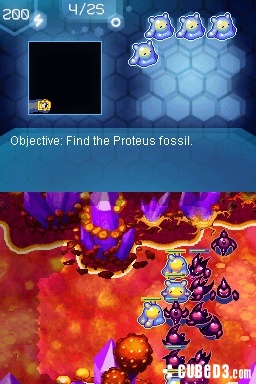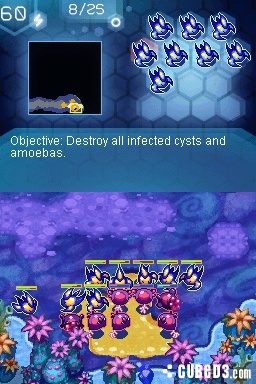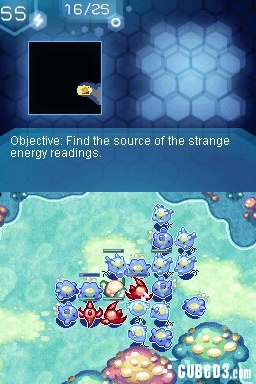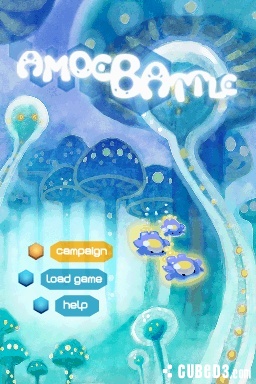Amoebattle (Nintendo DS) Review
By Dustin Chadwell  30.05.2012
30.05.2012

Amoebattle for the DSiWare service started off as a Nintendo exclusive, but ended up as an iOS title first before arrive on the DSi download store. It attempts to bring a standard RTS game to handhelds, using a touch interface that actually works quite well. The entire experience isn’t perfect, but for a genre that is woefully under-utilised on just about every handheld platform on the market today, Amoebattle provides a fun experience that will give players that RTS on the go fix they have been looking for.
Developed by Grab Games, formerly Intrinsic Games, it comes from the same stable as other iOS and Facebook titles, but is mainly created by the team that made the superb Divergent Shift. Amoebattle features cute representations of different single-celled organisms that fall into three distinct categories; Herbivore, Carnivore, and Omnivore. Obvious licenses are taken with the concept of what an actual amoeba can do, as these three groups are divided across nine different species, which will battle it out across twelve different missions that make up Amoebattle’s campaign.
The touch screen control system is remarkably similar to the way an RTS would control on the PC, and any player that has spent time with Blizzard’s popular StarCraft series, or perhaps the Warhammer titles from Games Workshop, will see some control similarities instantly. In lieu of a traditional mouse interface, players will simply tap the amoeba units to control, and can even trace circles around groups of units to command a small army. The overall number of deployed amoebae at any given time is kept small enough to make this work well on the DSi screen, so it is not at all difficult to move or navigate around each map.
In addition to the touch screen controls, there is a pull-down menu that can be activated at any time by holding down the top-left button on the DSi. This pull-down menu gives players access to a few more abilities, the most important of which is one that allows players to divide current amoebae, which is the primary way of increasing the amoeba army. As amoebae attack and defeat foes, or feed at the different algae points spread across each map, they will become full. This signifies to the player that the amoeba is ready to be split, which generally takes a few seconds and creates an entirely new unit.

This ability to recreate and resupply an army negates the need for more standard RTS devices like resource nodes, and structures designed to create more units. Not only can the player create more units when needed, new unit types can also be created assuming that certain requirements have been met. Each mission the player partakes in will have certain goals to meet, but the early missions will act more as a tutorial designed to teach the player when to create new units, when to evolve them into other units, and so on.
The difference between the three types of units -- Carnivore, Omnivore, and Herbivore -- boils down to a handful of abilities that each unit possesses. For instance, the Herbivores gain the ability to auto-heal and increase their overall strength when inside the range of the many algae feeding points on each map. While inside this area, they become virtually indestructible, and stationing a few amoebae at these points make them a pretty good deterrent to enemy forces just wandering nearby, thanks in part to their ranged attack capabilities.

The Omnivore class, which is the player’s starting class at the onset of the game, is more of an all-purpose build that doesn’t have any one particular weakness or strength. Their primary benefit comes from the fact that they can move through sections called Underbrush without any movement restrictions. Underbrush areas allow units to hide within, making the units inside the Underbrush undetectable to units outside. This allows Omnivores to either launch surprise attacks on wandering enemy units, or gives them a quick escape path when outnumbered, since non-Omnivore units will only move at half-speed when entering the Underbrush.
Finally, the Carnivore class is the brawler of Amoebattle, making them tough to kill and a force to be reckoned with in larger groups. Carnivores provide maximum damage to enemy units, but don’t possess any of the environmental skills given to either the Herbivore or Omnivore units. If the mission involves hunting down enemy units to kill, the Carnivore class is generally the best bet to get that done.
Amoebattle’s mission structure, as mentioned earlier, eases the player into the experience quite well. The early missions can be a bit of a bore depending on how quickly the player grasps the concepts, as the tutorial stages tend to get dragged out for a bit. However, once you hit mission four and onwards, the game really opens up and allows the player to sort of forge their own path when completing objectives. Also, the objectives are varied enough that the experience never feels like it’s getting long in the tooth, and the twelve missions are challenging enough that the player will feel like they have got their money’s worth out of the experience.

The only real fault noticed in Amoebattle has to do with the path finding abilities of individual units. When the group of amoebae being controlled hits the maximum size, it becomes difficult to make them move has a cohesive unit through some of the tighter spaces featured on different maps. Units will occasionally split off to move to the desired waypoint, which in turn can make them susceptible to enemy attacks while away from the main force. It can be a little troublesome to babysit these wayward units, but the map sizes are never so large as to lose track of them entirely, and it requires just a little more handholding to get them rounded up again.
Amoebattle is definitely an RTS with charm, and the cute amoeba-themed sprite based artwork really helps to sell the game past its interesting gameplay concepts. It also helps that there’s little in the way of competition for this particular genre on the DSiWare service, but even then Amoebattle is more than competent at what it sets out to provide. It’s definitely worth checking out for DSi owners, and will most likely prove to be a hidden gem on the service for years to come.

Cubed3 Rating
Very Good - Bronze Award

An interesting approach to a standard RTS style game on the DSiWare makes Amoebattle something that’s worth checking out. It might not have all the bells and whistles that accompany AAA titles like StarCraft, but its bite-sized presentation and unique approach to army management proves to be a suitable fit for portable gaming. It is certainly not the beefiest game out there when it comes to content, but it is still something that is worth a look.
Comments
Comments are currently disabled

 Sign In
Sign In Game Details
Game Details
 Out now
Out now  Out now
Out now  None
None  Out now
Out now  Subscribe to this topic
Subscribe to this topic Features
Features





 Top
Top

